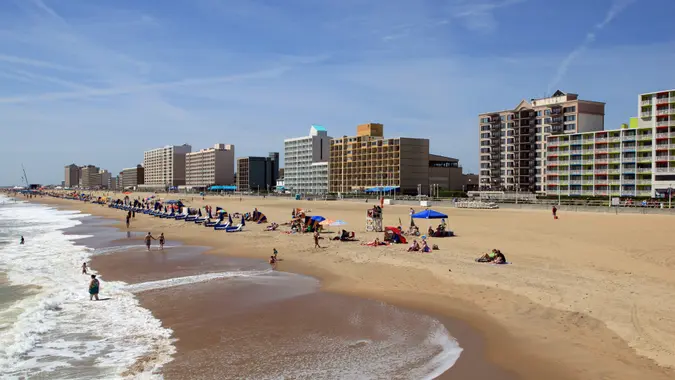How Long $1 Million in Retirement Will Last in Central America

Commitment to Our Readers
GOBankingRates' editorial team is committed to bringing you unbiased reviews and information. We use data-driven methodologies to evaluate financial products and services - our reviews and ratings are not influenced by advertisers. You can read more about our editorial guidelines and our products and services review methodology.

20 Years
Helping You Live Richer

Reviewed
by Experts

Trusted by
Millions of Readers
Want a comfortable or even luxurious lifestyle in retirement, but don’t think you can grow a multimillion dollar nest egg?
One million can go a lot further in Central America than it can in the US, Canada and other advanced economies. But that comes with tradeoffs, like any other major financial decision.
As you consider moving overseas for an earlier or more comfortable retirement, keep the following in mind.
A Lightning Overview of Withdrawal Rates
Before parsing how long $1 million would last you in retirement, you need a basic understanding of what financial planners call “safe withdrawal rates.”
You spend your career saving up a nest egg for retirement. Once you retire, you then start withdrawing money from your retirement portfolio. Which raises a question: How much can you safely withdraw from your nest egg each year, without worrying about running out of money before you kick the bucket?
For decades, the rule of thumb in financial planning circles has been the 4% Rule. It states that you can withdraw 4% of your nest egg in your first year of retirement, and then adjust upward for inflation each year after that. Based on historical market performance, your nest egg should last you at least 30 years.
Following the 4% Rule, you could withdraw $40,000 to live on, if you had a $1 million nest egg.
If you don’t need your nest egg to last as long, you can withdraw more of it each year. For example, Charles Schwab notes that you could withdraw 5.4-5.9% annually if you only want your money to last 20 years instead of 30. That means $54,000 to $59,000 per year if you start with a $1 million nest egg.
Conversely, if you want to retire young and have your nest egg last forever, you can’t withdraw as much each year. Financial planner Michael Kitces did his own analysis and found that a 3.5% withdrawal rate should leave your nest egg growing and intact indefinitely. That leaves you with just $35,000 per year from your $1 million nest egg.
Lifestyle Expectations
How long will your $1 million retirement last in Central America? The same length of time it will in the US or Canada or anywhere else.
If you want your $1 million nest egg to last 30 years, you can withdraw a $40,000 income. The difference lies in the quality of life you can expect from that $40,000.
Alec Kellzi, CPA at IRS Extension Online, paints a vivid picture. “Retiring in Central America with $1 million is akin to living like royalty. Virtually all expenses in Central America run dramatically less than the US.
“Housing eats up only 20-40% of comparable American costs whether renting or purchasing. The same applies to domestic help. Healthcare is the biggest bargain, prestigious private clinics charge 20-30% of US prices for equal care. Groceries, utilities, and transportation are all much more economical as well.”
Financial planner Rhett Stubbendeck, founder of Leverage Planning, has seen it firsthand. “A client of mine moved to Costa Rica and found her monthly expenses, including rent, groceries, and healthcare, were about half of what they were in the US. The quality of life can be high, too. Many retirees enjoy a relaxed lifestyle with great weather, outdoor activities, and a slower pace of life. My clients often mention the friendly communities and the joy of living near the beach or in scenic mountains.”
Costs & Quality of Life Vary by Country
Kellzi notes that different countries come with different costs of living — and different levels of economic development.
“In affordable havens like Guatemala, Honduras, and Nicaragua, that sizable nest egg could realistically last an energetic couple 30 years or more. With monthly budgets of $2,500 – $3,500 range that covers healthcare, dining, entertainment, and travel.
“Even in pricier spots like Panama, a $1 million bankroll equates to at least 20 years of tropical bliss when living moderately at $4,000 – $5,000 per month.”
Stubbendeck added that you can spend even less for a comfortable lifestyle. “In Panama, you can rent a nice apartment for around $1,000 a month. In the US, this could easily cost $2,500 or more. Healthcare is also more affordable. Another client needed dental work and found excellent care in Nicaragua at a fraction of the US cost.”
Personal finance expert Michael Ashley, founder of AshleyInsights.com, expanded on that point. “Healthcare is a fraction of the cost in countries such as Costa Rica, Panama, and Nicaragua, yet the quality is often comparable to the US. Housing costs, whether renting or buying, are much more affordable. Groceries, dining out, and entertainment expenses are also cheaper.
“In general, you can live comfortably on a budget of around $2,000 to $3,000 per month, depending on your lifestyle and the specific country you choose.”
Downsides of Retiring Overseas
Living abroad comes with plenty of perks. I should know — I live in South America myself.
But if it came with no drawbacks, everyone would do it. “There are challenges,” cautions Stubbendeck. “Adjusting to a new culture and language can be tough. Infrastructure may not always meet American standards, and some areas might lack certain conveniences.”
For many, the greatest downside is the distance to loved ones back home. Your kids and grandkids can’t swing by for dinner on a Tuesday night. You can’t spontaneously offer to take them to the zoo.
You can fly home whenever you like of course, or pay for your kids to come visit, but that costs money. Fly home too often and it could defeat the entire purpose of moving abroad to save money.
Start by visiting several countries in Central America to scout out expat enclaves or other likely prospects. If you can, spend a month living there as a trial run. You might fall in love — or you might decide that it’s simply not for you. Either way, you’ll get clearer on your retirement vision, and gain confidence in your plan.
 Written by
Written by  Edited by
Edited by 

























